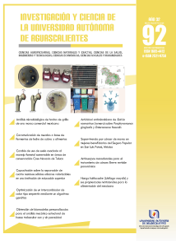Caracterización de mezclas a base de fermentos de leche de cabra y alimentos
DOI:
https://doi.org/10.33064/iycuaa2024924986Palabras clave:
Leche de cabra, bacterias ácido lácticas, probióticos, arándano, zanahoria, polloResumen
El objetivo de esta investigación fue formular mezclas de fermento de leche de cabra con pulpa de arándano, puré de zanahoria y carne de pollo. El fermento se obtuvo con leche de cabra y posteriormente fue mezclado con arándano, zanahoria o carne de pollo, proporción 50:50 (%v/v). Cada formulación fue evaluada microbiológicamente a los 7 y 30 días, contabilizando Unidades Formadoras en medio M17, BSM y MRS. El análisis de varianza registró diferencia significativa (p≤0.05) en los días evaluados, interacción alimento con medio de cultivo, después de 30 días aún se registraron más de 1x106 UFC mL-1 mínimo necesario para ser considerado probiótico. Las ca0072acterísticas fisicoquímicas que registraron diferencia significativa (p≤0.05) fueron el pH en carne de pollo y los oBx en arándano. Respecto al contenido de fenoles totales, no se registraron diferencias significativas (p≥0.05) en las formulaciones propuestas.
Descargas
Citas
• Arasu, M.V., Al-Dhabi, N.A., Ilavenil, S., Choi, K.C., Srigopalram, S. (2016). In vitro importance of probiotic Lactobacillus plantarum related to medical field. Saudi Journal of Biological Sciences, 23(1), S6-S10, https://doi.org/10.1016/j.sjbs.2015.09.022 DOI: https://doi.org/10.1016/j.sjbs.2015.09.022
• Balthazar, C. F., Silva, H. L., Esmerino, E. A., Rocha, R. S., Moraes, J., Carmo, M.A., & Cruz, A. G. (2018). The addition of inulin and Lactobacillus casei 01 in sheep milk ice cream. Food Chemistry, 246, 464-472. DOI: https://doi.org/10.1016/j.foodchem.2017.12.002
• De Moraes, G.M.D. 2017. Functional Properties of Lactobacillus mucosae Strains Isolated from Brazilian Goat Milk. Probiotics and Antimicrobial Proteins, 9(3), 235-245. DOI: https://doi.org/10.1007/s12602-016-9244-8
• Duke, J. A. 1997. The Green Pharmacy. Emmaus, PA: Rodale Press. 528p.
• Gallego, C. G., & Salminen, S. (2016). Novel probiotics and prebiotics, how can they help in human gut microbiota dysbiosis?, Applied Food Biotechnology, 3, 72–81.
• Granato, D., Barba, F. J., Bursać Kovačević, D., Lorenzo, J. M., Cruz, A. G., & Putnik, P. (2020). Functional foods: Product development, technological trends, efficacy testing, and safety. Annual Review of Food Science and Technology, 11, 93–118. https://doi.org/10.1146/annurev-food-032519-051708 DOI: https://doi.org/10.1146/annurev-food-032519-051708
• Hailemariam, A., Esatu, W., Abegaz, S., Urge, M., Assefa, G. & Dessie, T. (2022). Nutritional composition and sensory characteristics of breast meat from different chickens, Applied Food Research, 2(2), 100233, https://doi.org/10.1016/j.afres.2022.100233. DOI: https://doi.org/10.1016/j.afres.2022.100233
• Hodgkinson, A. J., Wallace, O. A., Boggs, I., Broadhurst, M., & Prosser, C. G. (2018). Gastric digestion of cow and goat milk, impact of infant and young child in vitro digestion conditions. Food Chemistry, 245, 275–281. DOI: https://doi.org/10.1016/j.foodchem.2017.10.028
• Kumar, H., Dhalaria, R., Guleria, S., Cimler, R., Choudhary, R., Dhanjal, D.S., Singh, R., Kimta, N., Dulta, K., Pathera, A.K., Khan, A., Nausad, M., Alomar, S.Y., Manickam, S., Kuča, K. (2023). To exploring the role of probiotics, plant-based fermented products, and paraprobiotics as anti-inflammatory agents in promoting human health. Journal of Agriculture and Food Research, 14:100896, https://doi.org/10.1016/j.jafr.2023.100896. DOI: https://doi.org/10.1016/j.jafr.2023.100896
• Li, T. S. (2008). Vegetables and fruits: Nutritional and therapeutic values. Boca Raton, FL: CRC Press. 286p. https://doi.org/10.1080/10496500802701846 DOI: https://doi.org/10.1080/10496500802701846
• Liu, D., Zhao, F., Li, L., Zhang, J., Wu, S., Lü, X., Zhang, H. & Yi, Y. (2023). Enhancing the antioxidant capacity and quality attributes of fermented goat milk through synergistic action of Limosilactobacillus fermentum WXZ 2-1 with starter culture, Journal of Dairy Science, Article in press. https://doi.org/10.3168/jds.2023-24135 DOI: https://doi.org/10.3168/jds.2023-24135
• McGhee, C.E., Jones, J.O., & Park, Y.W. (2015). Evaluation of textural and sensory characteristics of three types of low-fat goat milk ice cream. Small Ruminant Research, 123, 293–300. DOI: https://doi.org/10.1016/j.smallrumres.2014.12.002
• Mituniewicz-Malek, A., Zielinska, D., & Ziarno, M. (2019). Probiotic monocultures in fermented goat milk beverages-sensory quality of final product. International Journal of Dairy Technology, 72, 1–8. DOI: https://doi.org/10.1111/1471-0307.12576
• Nguyen, B.T., Bujna, E., Fekete, N., Tran, A., Rezessy-Szabo, J., Prasad, R., & Nguyen, Q. (2019). Probiotic beverage from pineapple juice fermented with Lactobacillus and Bifidobacterium strains. Frontiers in Nutrition, 6(54),1-7. doi: 10.3389/fnut.2019.00054 DOI: https://doi.org/10.3389/fnut.2019.00054
• Panghal, A., Janghu, S., Virkar, K., Gat, Y., Kumar, V., & Chhikara, N. (2018). Potential non-dairy probiotic products—a healthy approach. Food Bioscience, 21,80–89. DOI: https://doi.org/10.1016/j.fbio.2017.12.003
• Ranadheera, C. (2017). Probiotic delivery through fermentation: Dairy vs. Non-Dairy beverages. Fermentation, 3(4), 67. DOI: https://doi.org/10.3390/fermentation3040067
• Reyes, I. Y., Villacres, C. E., Santacruz, S. G., Castro, M. R., & Armas, A. C. (2019). Efecto antibacteriano y antioxidante de frutos rojos ecuatorianos sobre streptococcus mutans: estudio in vitro. Odontología Vita, 31, 23–30. DOI: https://doi.org/10.59334/ROV.v2i31.323
• Silva, F., Queiroga, R., de Souza, E., Voss, G., Borges, G., Lima, M., Pintado, M., Vasconcelos, M. (2022). Incorporation of phenolic-rich ingredients from integral valorization of Isabel grape improves the nutritional, functional and sensory characteristics of probiotic goat milk yogurt, Food Chemistry, 369,130957. https://doi.org/10.1016/j.foodchem.2021.130957. DOI: https://doi.org/10.1016/j.foodchem.2021.130957
• Tombozara, N., Donnoc, D., Razafindrakotoa, Z., Randriamampiononaa, D., & Beccaro, G. L. (2020). The first assessment on antioxidant and antidiabetic activities of leaves and stems of Vaccinium secundiflorum Hook. (Ericaceae), an endemic plant of Madagascar. South African Journal of Botany, 130, 422-429. DOI: https://doi.org/10.1016/j.sajb.2020.01.035
• Tripathi, M.K., & Giri, S.K. (2014). Probiotic functional foods: Survival of probiotics during processing and storage. Journal of Functional Foods, 9, 225–241. DOI: https://doi.org/10.1016/j.jff.2014.04.030
Descargas
Publicado
Cómo citar
Número
Sección
Categorías
Licencia
Derechos de autor 2024 Carolina Ramírez-López, José Hugo Castorena-García, Anne Karen Rojas-Martínez, Víctor Santiago-Santiago, Maribel Cano-Hernández

Esta obra está bajo una licencia internacional Creative Commons Atribución-NoComercial-CompartirIgual 4.0.
Las obras publicadas en versión electrónica de la revista están bajo la licencia Creative Commons Atribución-NoComercial-CompartirIgual 4.0 Internacional (CC BY-NC-SA 4.0)









